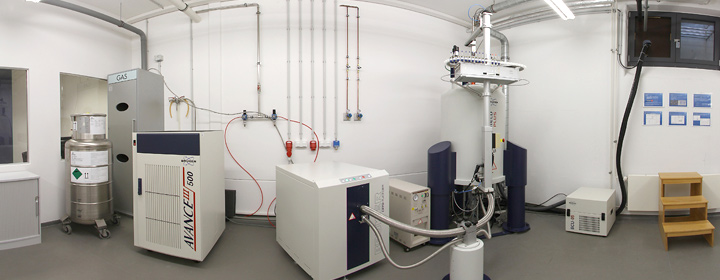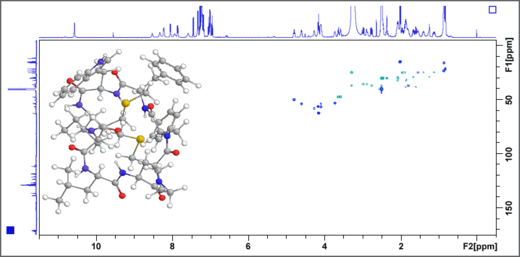
NMR spectrometer:
| AV 500 | AV 400 | |
|---|---|---|
| Magnet: | 500 MHz ultrashield plus | 400 MHz ultrashield |
| Console: | Bruker Avance III | Bruker Avance III |
| Probes: | Triple Res. Cryo-TCI (1H/13C/15N) Broadband Inverse BBI (1H, BB) Z-Gradient, ATM |
Broadband Observe BBFOplus (BB, 1H) Broadband Inverse BBI (1H, BB) Z-Gradient, ATM |
| Software: | TopSpin 2.1, AMIX 3.913 | TopSpin 3.0 |
| Automation: | BACS 60 | NMR Case |
The 500 MHz AV III system is used for the structure determination of previously unknown bioactive natural products, functional food constituents, and metabolites. COSY, TOCSY, HSQC, HMBC, ADEQUATE, and INADEQUATE experiments give valuable information on the constitution of the target molecule, whereas NOESY and ROESY experiments deliver important insights into the structural conformation of the molecule.
Stable isotope labelling experiments with NMR diagnostic analysis of 13C-13C couplings (e.g. the carbon bond labelling technique) allow for the visualization of the joint transfer of labelled atoms from a precursor into a target molecule and give valuable information on (bio)chemical transformation pathways.
Analysis of complex natural compound mixtures such as, e.g. biosamples (urine, plasma etc.), food (coffee, wine etc.), or fermentations (yeast, soy sauce, etc.) and the quantitation of their constituents are performed by 1H NMR spectroscopy with or without water pre-saturation and in addition with J-Resolved experiments.
Verification of syntheses, purity assessment as well as quantitative NMR (qNMR) spectroscopy is performed on the 400 MHz system. Using the principle of reciprocity enables the possibility of quantification via an external calibrant within an error limit of ± 2%.
NMR (Nuclear Magnetic Resonance)
Nuclear magnetic resonance spectroscopy, most commonly known as NMR spectroscopy, is today considered a key spectroscopic tool in modern natural product chemistry. In particular, 2-dimensional NMR experiments like COSY, TOCSY, NOESY, ROESY as well as HSQC and HMBC are frequently used to get a detailed picture of the structure and conformation of a given molecule.
In addition, qNMR spectroscopy enables the precise quantification of organic molecules in complex mixtures such as, e.g. urine, plasma, food extracts, as well as the purity assessment of isolated molecules to be used as internal standards for quantitative studies or as reference material for bioactivity testing.
